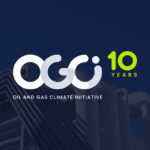- This is a further step in support of the Paris Agreement by the companies leading the oil and gas industry response to climate change
- OGCI member companies set a target to reduce by 2025 the collective average carbon intensity of their aggregated upstream oil and gas operations
New York, July 16, 2020 – The Oil and Gas Climate Initiative (OGCI) today announced a target to reduce the collective average carbon intensity of member companies’ aggregated upstream oil and gas operations to between 20 kg and 21 kg CO2e/boe by 2025, from a collective baseline of 23 kg CO2e/boe in 2017.
The range is consistent with the reduction needed across the oil and gas industry by 2025 to support the Paris Agreement goals[1]. The target represents a reduction of between 36 and 52 million tonnes of CO2e per year by 2025 (assuming constant levels of marketed oil and gas production), equivalent to the CO2 emissions from energy use in between 4 and 6 million homes.[2]
OGCI wants to play an active role in accelerating and shaping the global pathway to net zero emissions through collective and practical actions. This carbon intensity target is a near-term and practical step for member companies to continue to expand their contribution to the transition to a low carbon economy.
The target covers both carbon dioxide and methane emissions from OGCI member companies’ operated upstream oil and gas exploration and production activities, as well as emissions from associated imports of electricity and steam. OGCI will be working on specific actions on emissions from liquefied natural gas (LNG) and gas-to-liquids (GTL), to take their collective ambitions further[3]. Carbon intensity is calculated as a share of marketed oil and gas production.
In a joint statement, the CEOs of the OGCI member companies said: “Encouraged by the progress we have made towards our target on methane intensity, we have come together to reduce by 2025 the collective average carbon intensity of our aggregated upstream oil and gas emissions. Together we are increasing the speed, scale, and impact of our actions to address climate change, as the world aims for net zero emissions as early as possible.”
To contribute to the reduction of their collective average carbon intensity, OGCI member companies are implementing a range of measures in their own operations, including improving energy efficiency, reducing methane emissions, minimizing flaring, electrifying operations using renewable electricity where possible, co-generating electricity and useful heat and deploying carbon capture, utilization and storage.
OGCI’s collective carbon intensity will be reported on an annual basis consistent with the OGCI public reporting methodology and assumptions[4], with data reviewed by EY, as an independent third party. While methane emissions will be included in the carbon intensity target, representing up to a quarter of the improvement, OGCI will also continue to separately report progress on reducing methane intensity.
[1] Extrapolated on the same perimeter from IPCC AR4 data and International Energy Agency data (World Economic Outlook 2018 and 2019 editions and the IEA special report The Oil and Gas Industry in Energy Transitions, 2020).
[2] Data based on US energy usage.
[3] Note that the collective 2017 baseline of 23 kg CO2e/boe referenced above is a reduction from the 2017 baseline reported in the Annual Report 2019. This reduction is a result of excluding emissions from LNG and GTL.
[4] See the OGCI Reporting Framework
ABOUT THE OIL AND GAS CLIMATE INITIATIVE:
The Oil and Gas Climate Initiative is a CEO-led consortium that aims to accelerate the industry response to climate change. OGCI member companies explicitly support the Paris Agreement and its goals. As leaders in the industry, accounting for over 30% of global operated oil and gas production, we aim to play an active role in shaping the global pathway to net zero emissions. We do this by leveraging the collective strengths of OGCI, continually improving, and building on good international corporate practices to reduce greenhouse gas emissions and accelerate transitions to a low-carbon future.
Our members collectively invest over $7B each year in low carbon solutions. OGCI Climate Investments, our $1B+ fund, invests in solutions to decarbonize sectors like oil and gas, industrials and commercial transport. OGCI includes BP, Chevron, CNPC, Eni, Equinor, ExxonMobil, Occidental, Petrobras, Repsol, Saudi Aramco, Shell and Total.
To learn more about OGCI, please visit www.ogci.com.
Media contact:
+44 (0)207 413 3711





